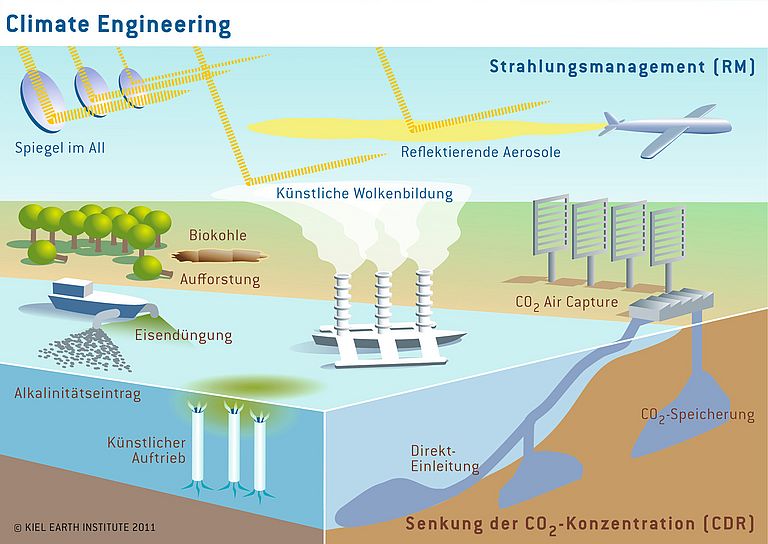Can Climate Engineering Solve the Climate Problem?
GEOMAR coordinates research program for evaluating industrial climate regulation
The experiment has long since begun. Since the start of industrialization approximately 200 years ago, humans have been producing enormous amounts of carbon dioxide and letting it escape into the air. Thus unconsciously they started a long and uncontrolled experiment with the earth’s atmosphere. Meanwhile we know the results: The carbon dioxide level has risen more than a third. The additional CO2 increases the natural greenhouse effect and the average temperature on earth is rising; the climate is changing. Now there is a need for methods to limit the consequences of this unintentional experiment.
The easiest way would theoretically be to quickly decrease carbon dioxide emissions. However with a fast growing world population and the current impetus for industrialization in large emerging countries, this would prove rather difficult in practice. Therefore industrial measures are being increasingly discussed. These could be applied specifically to lower the CO2 concentration in the atmosphere or to diminish the intensity of solar radiation. “These industrial measures are summed up in the term ‘climate engineering’,” describes Professor Andreas Oschlies from GEOMAR Helmholtz Centre for Ocean Research Kiel. “Yet so far there is no reliable information on the potential of these measures, nor their side effects,” continues Oschlies.
In order to form a scientific basis for the discussion of climate engineering, the German Research Foundation (DFG) has now approved a priority program called “Climate Engineering: Risks, Challenges, Opportunities?” The application by Professor Oschlies was an initiative of the Kiel Earth Institute (KEI), supported by the Cluster of Excellence “The Future Ocean” and a core group of 18 scientists from universities and institutions all over Germany. In the next six years the priority program, divided into eight sub-projects, will examine the considerable uncertainties associated with the concept of climate engineering. The DFG is allocating five million Euros for the first three years of the project. 1.3 million Euros will go to the coordinating office in Kiel and two sub-projects that will be carried out by GEOMAR and the Kiel Earth Institute together with the Max-Planck-Institute for Meteorology in Hamburg, Kiel University and the “Institute for Technology” (KIT) in Karlsruhe.
The participating scientists concern themselves not only with the natural science dimension but with the social, political, judicial and ethical aspects of the discussed measures as well. “In all the concepts suggested so far, climate engineering would have at least interregional and frequently also time-delayed consequences. This makes the evaluation difficult,” emphasizes Professor Oschlies. Who would actually be allowed to decide on the use of climate engineering? Who would be responsible for the side effects? “These questions must also be examined. Exactly this multidimensionality has not been given enough thought in international research up to now,” says Oschlies. The approved priority program will examine this topic with an internationally unique breadth of expertise. Thus a solid basis for the elaborate consideration of possible pros and cons will be established.
This can provide arguments for today’s international climate-political discussions where some players are turning away from CO2 emission avoidance in the face of climate engineering. Ultimately the extensive analysis of the risks and (side) effects of climate engineering is meant to build a basis for well-founded social decisions about the possible use of climate engineering. A well informed public is therefore also very important for the scientists. In September 2011 the Kiel Earth Institute set up a website www.climate-engineering.eu for this purpose. News and information on climate engineering is brought together daily in order to provide more transparency to the debate. The website will also be used for the priority program.
Background Information: The Kiel Earth Institute
The Kiel Earth Institute (KEI) researches important topics on global change and its social consequences. KEI is the result of an initiative by GEOMAR Helmholtz Centre for Ocean Research Kiel and the Institute for the World Economy (IfW).
Contact:
Jan Steffen (GEOMAR, Communication & Media), Tel.: +49 431 600 2811
jsteffen(at)geomar.de



